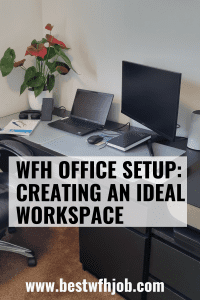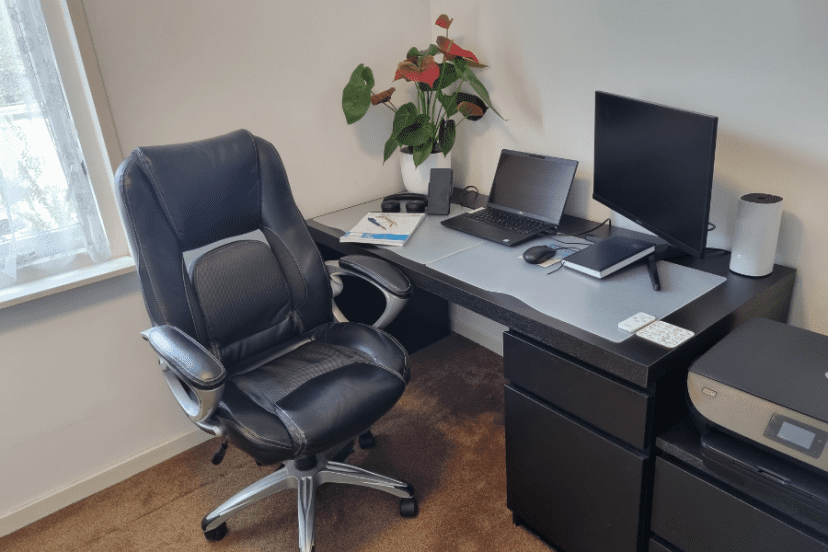WFH Office Setup: Creating an Ideal Workspace for Productivity and Comfort
As someone who is passionate about creating an efficient and productive work environment, I understand the significance of a well-designed home office. With the rise of remote work opportunities, having a dedicated space that caters to your professional needs has become essential. In this article, I will provide you with valuable WFH office setup insights and suggestions for an ideal home office. Let’s dive in!
1. Introduction
Working from the comfort of your own home can be liberating, but it also requires careful consideration of your workspace. By creating a home office that aligns with your work requirements and personal preferences, you can enhance your productivity and overall well-being.
2. Assessing the Space
The first step in setting up your home office is assessing the available space. Whether you have an entire room or a small corner, it’s crucial to determine a dedicated area for work. Consider the following factors:
2.1 Determining the Dedicated Area
Identify a space where you can establish your work zone. This could be a spare room, an unused corner, or even a portion of your living area. Select an area that offers privacy and minimizes distractions, allowing you to focus on your tasks effectively.
2.2 Evaluating Lighting Conditions
Lighting plays a vital role in maintaining your concentration and reducing eye strain. Natural light is preferred, as it provides a sense of openness and boosts a positive mood.
If natural light is limited, ensure you have sufficient artificial lighting options to illuminate your workspace adequately.
3. Ergonomic Considerations
Creating an ergonomic home office setup is crucial for your long-term comfort and health. Take into account the following aspects:
3.1 Choosing a Comfortable Chair
Invest in a good-quality ergonomic chair that supports your posture and provides proper lumbar support. This will help prevent back pain and enhance your overall comfort during long working hours.
3.2 Selecting the Right Desk
Choose a desk that offers ample surface area for your work essentials. Ensure it is at an appropriate height, allowing your arms to rest comfortably on the desk while maintaining a 90-degree angle at the elbows.
4. Essential Equipment and Accessories
Equipping your home office with the necessary tools and accessories is vital for a smooth workflow. Consider the following essentials:
4.1 Reliable Computer or Laptop
Select a computer or laptop that meets your professional requirements. Consider the nature of your work and the software you use to ensure your device can handle the tasks efficiently.
4.2 High-Speed Internet Connection
A stable and high-speed internet connection is indispensable for remote work. Research the available options in your area and choose a reliable service provider that offers fast and consistent connectivity.
4.3 Quality Monitor(s)
Invest in a high-resolution monitor or dual monitors, depending on your work demands. This will enhance your visual experience and allow for better multitasking.
4.4 Keyboard and Mouse
Choose a keyboard and mouse that offer ergonomic design features. These peripherals should be comfortable to use and promote proper hand and wrist positioning.
4.5 Adequate Storage Solutions
Optimize your storage options by incorporating shelves, cabinets, or drawers to keep your documents and supplies organized. This will help reduce clutter and improve your efficiency.
5. Organizational Systems
An organized workspace contributes to a focused and productive mindset. Implement the following organizational systems:
5.1 Filing and Storage Options
Use filing cabinets or folders to categorize and store important documents. Create a logical system that allows for easy retrieval when needed.
5.2 Cable Management
Tackle cable clutter by using cable management solutions such as cable clips, cable sleeves, or cable trays. Keeping cables organized not only improves aesthetics but also prevents tripping hazards.
5.3 Desk Organization
Utilize desk organizers, trays, and containers to keep frequently used items within reach. Having a clutter-free desk promotes a clear mind and reduces distractions.
6. Lighting and Ambience
The right lighting and ambiance can significantly impact your mood and productivity. Consider the following elements:
6.1 Natural and Artificial Lighting
Maximize natural light by positioning your desk near windows. If natural light is limited, supplement it with warm and adjustable artificial lighting options to create a comfortable atmosphere.
6.2 Incorporating Greenery
Introduce plants into your home office to enhance the overall aesthetic and improve air quality. Plants have a calming effect and can boost your mood and creativity.
6.3 Sound Management
Minimize external noises by using noise-canceling headphones or playing soothing background music. A serene auditory environment allows you to concentrate better and stay focused on your work.
7. Personalization and Inspiration
Adding personal touches to your home office can create a motivating and inspiring atmosphere. Consider the following ideas:
7.1 Decorative Touches
Hang artwork or display meaningful items that inspire you. Personalize your workspace with objects that reflect your interests and aspirations.
7.2 Motivational Elements
Place motivational quotes or affirmations in visible areas. These reminders can uplift your spirits and help you stay motivated during challenging times.
8. Optimizing Productivity
Creating a conducive environment for productivity is crucial when working from home. Implement the following strategies:
8.1 Creating a Distraction-Free Environment
Minimize distractions by eliminating or reducing potential interruptions. Communicate with family members or roommates about your work hours and establish boundaries to maintain focus.
8.2 Establishing a Routine
Set a consistent work routine that aligns with your peak productivity hours. Having a structured schedule helps create a sense of normalcy and discipline.
8.3 Setting Boundaries
Clearly define boundaries between your work and personal life. Avoid working outside designated hours and establish a healthy work-life balance to prevent burnout.
9. Health and Wellness
Prioritizing your physical and mental well-being is essential for sustained productivity. Consider the following practices:
9.1 Incorporating Movement
Take short breaks to stretch, walk, or engage in light exercises. Incorporating movement into your work routine improves blood circulation and helps combat sedentary behavior.
9.2 Ergonomic Breaks
Practice regular ergonomic breaks to relieve muscle tension and prevent strain. Simple exercises and stretches can alleviate discomfort and increase your energy levels.
9.3 Mindfulness Practices
Incorporate mindfulness techniques such as deep breathing exercises or meditation to reduce stress and enhance focus. Taking a few minutes for mindfulness can rejuvenate your mind and improve your overall well-being.
10. Conclusion
Designing and implementing your ideal WFH office setup arrangements requires careful consideration of various factors. By assessing your space, prioritizing ergonomics, and equipping yourself with the necessary tools, you can create an environment that promotes productivity and well-being. Remember to personalize your workspace, optimize lighting, and establish routines that work for you. With a well-designed home office, you can maximize your work-from-home opportunities and thrive in your professional endeavors.
11. FAQs
1. What if I don’t have a dedicated room for a home office?
Your WFH office setup and implementation plans shouldn’t be discouraged if you don’t have a dedicated room.
Find a quiet corner or unused space in your home that can be designated as your work area. With creative organization and proper boundaries, you can still create an effective home office setup.
2. Is it necessary to invest in an ergonomic chair?
Investing in an ergonomic chair is highly recommended. It provides proper support to your back and promotes good posture, reducing the risk of musculoskeletal issues and enhancing your comfort during long work hours.
3. How can I minimize cable clutter in my home office?
To minimize cable clutter, use cable management solutions such as clips, sleeves, or trays. These will help keep your cables organized, prevent tangling, and improve the overall aesthetics of your workspace.
4. Can I personalize my home office even if it’s a shared space?
Absolutely! Even if you share your home office space with others, you can still personalize it with items that inspire and motivate you. Use decorative touches and personal mementos to create a space that reflects your personality and keeps you motivated.
5. How important is it to establish boundaries between work and personal life?
Establishing boundaries between work and personal life is crucial for maintaining a healthy work-life balance. Clearly define your work hours, communicate them to others, and avoid overworking or bringing work-related stress into your personal time.






okay